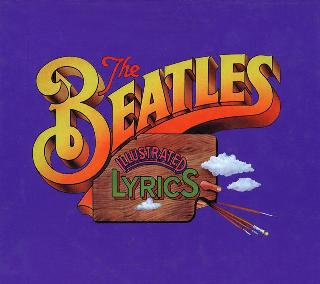Index
Home
Vorige
Sgt. Pepper's Lonely Hearts Club Band
Composer(s) : Lennon and McCartney
Year : 1967
Chords/Tabs: Sgt. Pepper's Lonely Hearts Club Band
Notes on "Sgt. Pepper's Lonely Hearts Club Band" (SPLHCB)
KEY G Major
METER 4/4
FORM Intro (instrumental) -> Verse -> Bridge (instrumental) -> Refrain ->
Bridge -> Verse -> Outro (segue al subito)
GENERAL POINTS OF INTEREST
Style and Form
- This opening track, "from an album of the same name", is as fine
an example of Beatlesque stylistic indeterminacy as you can find. How
else to explain how a song that is otherwise so sweatily suffused with
hard syncopation and bluesy bent notes should leave one with the overall
sensation of a strutting cakewalk? (That's a rhetorical question, son.)
- I'm willing to make the argument (though not comprehensively within
the space of a single page of text) that looking all the way back on it,
the Beatles had always had a great capability and penchant for "style
bending" (in the sense the term is used with respect to "gender"); and
that given a running start from _Revolver_, nowhere is this peculiar
source of strength more evident than on "Sgt. Pepper's." And as is its
compositional prerogative, the first track surely sets the tone.
- Formalistically, there's the totally unrelated issue of how the use
of *both* a bridge and refrain here, in absolute arch-like symmetry
makes the song feel longer than its scan 2 minute length; remember,
that ~10 seconds of that 2 minutes is the opening crowd/tuning noise!
Melody and Harmony
- Melodically, the song is barely one notch up from a talkin' blues patter
song; compare the official version with a most arch concert performance
of it by one Jimi Hendrix!! Far from a flaw, this only goes to allow
your attention to be drawn to other more actively exploited production
values.
- Harmonically, the song is heavily based upon one of *the* archtypal
Beatles chord progression; the I->V-of-V->IV->I one first heard back
in "Eight Days A Week." The hallmark of this
progression is the
combined chromatic cross-relation and psychological feeling of
deferred gratification created by following V-of-V (with its C#)
by IV (with its C natural).
I strongly suspect that this chord progression is the original
property of Lennon & McCartney though in terms of pure scholarship
I unfortunately cannot vouch for it 100%. I'll tell you this, though:
if anyone out there can point me to an example of this progression
appearing in a pop song prior to the Beatles, you can call or email
me just about any time of the day or night.
- As if encouraged by the chord progression or the bluesy bent thirds
of the vocal track, the harmony of the song features other cross-
relations in the guise of Major/minor plays upon the I/i chord.
Arrangement
- As with many a Beatles song of this period, a rock-instrumented
backing track lies firmly embedded within the foundation of the
recording. Don't allow any of the overdubbed effects to blunt your
sensitivity to the well executed bassline, lead guitar licks and
drumming.
- The parts for a quartet of French horns are deftly, if rather absurd-
cum-iconically, in-laid. The appearance of bowed string instruments
in the fade-up ambient noise (and nowhere else in this track) only
heightens the irony, while also setting up the plusibility of such
strings showing up later for
"She's Leaving Home" and
"A Day in the Life."
- In the department of Nothing-Left-To-Chance, it is interesting to
plot the programatic/structural use of the crowd noise. In the opening
seconds of the track you hear a rather passive audience chatting non-
descriptively amongst themselves, backed by the string section tuning.
But once the proceedings get under way, the audience gets right on the
edge of their participative seats: the transition from second verse to
first bridge features applause followed by inexplicably motivated
laughter -
- someone makes a gooney face, you suppose ? The final
verse provides more applause, building through the intro into
anticipatory SCREAMING!! (Shades of Bealtlemania Past).
- The vocal arrangement is quite vintage, with Macca screaming single-
tracked solo in the verses with a chorus of the others, in which the timbre
of John's voice figures prominently, for the refrain and second bridge.
SECTION-BY-SECTION WALKTHROUGH
Intro
- The track fades in with more than 10 seconds of concert hall audience
ambience and orchestral tuning over which the four-measure intro proper
abruptly intrudes itself:
|A |- |C |G |
G: V-of-V IV I
- The harmonic shape of this intro is convergent on the home key,
though you don't quite realize it at first. Given your inevitable
propensity to assume the opening chord is I, the shift to from
V-of-V to IV, with its cross-relation feels especially novel.
- This is, by the way, far from the first Beatles album to open with
a hammer stroke on a chord other than the one of the home key; try
_With the Beatles_, _A Hard Day's Night_, Beatles For Sale, and _Help!_.
Verse
- The verse is a standard eight measures long and parses into a
an AAB form of (2 * 2 + 4):
--------------- 2X --------------
|G A |C G |
G: I V-of-V IV I
|A |C |G C |G |
V-of-V IV I IV I
C: V
- The harmonic shape is almost a little too closely bound to the home
key, and the sudden slowing down of the harmonic rhythm in measures
5 & 6 adds some well-needed feeling of room in which to spread out.
- The vocal part of the last four measures places repeated emphasis
on the flat blue 3rd, turning the C chord into a C7, and creating
a minor/Major cross-relation in the last against the I chords.
- I'll give the IV label to the penultimate chord of this section,
though you'll note that Macca implies a kind of V chord with his
bassline (which I hear as G -> B -> C -> C# -> D->|G).
Bridge
- The bridge is five measures long and parses into two roughly
parallel, though uneven phrases (AA'); the elongated second
phrase lending the section a rhetorical, declamatory feel.
- The two bridges are differentiated by more than their different
arrangements and melodic content. A very subtle difference in the
choice between which two chords is given a dominant 7th gives each
bridge an alternate harmonic profile.
- The instrumental bridge opens with a dominant 7th chord on C, and
this makes the first half of it sound like a short-lived modulation
to the key of F Major, which in context of a G Major home key is a
relatively distant relation:
|C7 |F |C |D |- |
F: V I V
G:IV V
- The vocal bridge places the dominant 7th on the F chord. This allows
you to hear the opening of the section as though the short-lived
modulation were to the more closely related key of C, with the F chord
sounding like a plain old IV chord whose 7th is more a bluesy
embellishment than a structural dominant:
|C |F7 |C |D |- |
C: I IV I
G:IV V
Refrain
- *This* is the song's center of gravity: it is the longest of the
sections, formalistically it is an arch's keystone, and of course
it reiterates many times the words of the title. Think about how
the infamous "reprise" on side two consists of ONLY this refrain
repeated twice, and you almost would never even notice that fact;
rather, you passively recall the reprise as merely being "somehow
shorter."
- The twelve measure length parses into an AA'B form of three equal
phrases. Though the harmony is nothing like the traditional 12-bar
blues form, the poetry of 3-times-4 almost inevitably suggests something
of the blues in any event:
|G g |C G |C |G |
I i6/3 IV I IV I
|G g |C G |A |D |
I i6/3 IV I V-of-V V
|C |G |A |C D G |
IV V V-of-V IV (V)I
- Cross-relations and other dissonance abounds here: the Major/minor
switch on the I chord (with the minor one presented in first inversion),
the 4->3 appoggiatura on the C chord (downbeat of measures 2 & 5), the
bluesy minor 3rd in the tune clashing with the D chord (measure 8),
and the implied" V9 chord in the middle of measure 12, implied by the
descending melodic line (F->*E*->D) and Paul's placement of the D
in the bassline.
- Favorite details in the arrangement: the vacuum cleaner-like sound
of parallel fifths in the bass part, and the final rhythmic gesture
on "and FOUR," which somehow reminds me of
"Love Me Do."
Outro
- We seen many an intro starting on a chord other than I, but this
type of outro on IV is relatively unusual; just two measures of
the chord vamped over a stepwise descending bassline:
|C |- |
IV
- I'll stand behind the track demarcations of the CD and say that
the song ends here in some sense, though obviously, its direct segue
into the next track is really more to the musical point. This type
of stringing songs together reaches an apotheosis in the _Abbey Road_
medley, but this track, not to mention several others on SPLHCB and
the White Album are where you find the beginning of their experiments
in this direction.
SOME FINAL THOUGHTS
- This is the one and only time in the canon that the band refers to
both "us" (directly and collectively), and themselves in the first
person plural within the same song.
- Yes, there's the BBC-oriented
"From Us To You" but that's not quite part
of canon. And while they do refer to themselves as a group in
"Yellow Submarine,"
the latter song makes a critically different impression for
its lack of reference to *us*; note carefully -
- their *friends* (some
group of third persons) are on board, but we're not invited.
- This unique person-to-person stance, on the first track of the album,
no less, is not to be under-estimated as a factor in the transformation
of the Beatles' image with the release of Sgt. Peppers. I dare say
the spritual buzz kindled in us by the Anthology is in no small part
due to a remanifestation of this same stance; however belatedly or
incompletely it is, as alas, it must be.
Regards,
Alan (awp@world.std.com)
---
"I don't really want to stop the show, but I thought you might like to
know ..." 112195#106
---
Copyright (c) 1995 by Alan W. Pollack
All Rights Reserved
This article may be reproduced, retransmitted, redistributed and
otherwise propagated at will, provided that this notice remains
intact and in place.
Ook op Sgt. Pepper's Lonely Hearts Club Band:
Ook op Yellow Submarine Soundtrack:
Ook op 1967-1970:
(c) 2024 Serge Girard


 (c) Alan Aldrigde, The Beatles Illustrated Lyrics
(c) Alan Aldrigde, The Beatles Illustrated Lyrics